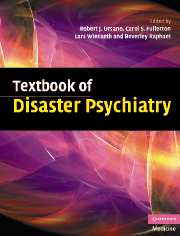Book contents
- Frontmatter
- Contents
- List of contributors
- Preface
- Part I Introduction
- Part II Foundations of disaster psychiatry
- Part III Clinical care and interventions
- Part IV Special topics
- 11 Traumatic death in terrorism and disasters
- 12 Weapons of mass destruction and pandemics: global disasters with mass destruction and mass disruption
- 13 Workplace disaster preparedness and response
- 14 Healthcare systems planning
- Part V Public health and disaster psychiatry
- Index
- References
14 - Healthcare systems planning
from Part IV - Special topics
Published online by Cambridge University Press: 09 August 2009
- Frontmatter
- Contents
- List of contributors
- Preface
- Part I Introduction
- Part II Foundations of disaster psychiatry
- Part III Clinical care and interventions
- Part IV Special topics
- 11 Traumatic death in terrorism and disasters
- 12 Weapons of mass destruction and pandemics: global disasters with mass destruction and mass disruption
- 13 Workplace disaster preparedness and response
- 14 Healthcare systems planning
- Part V Public health and disaster psychiatry
- Index
- References
Summary
Introduction
Few things are axiomatic in the field of disaster mental health. The need to plan and value of preparation for extraordinary events are on this short list. This level of consensus probably stems more from the demonstrated value of preparation inherent in seemingly unrelated areas such as national defense, community and personal protection, and the anthropological legacy, at least in the European context, of needing to preserve and store food for winter. Being prepared seems to work better than not being prepared. There is little argument about the value of anticipating what is possible and probable, identifying what needs to be done and who is to do it, and setting about the task of getting ready. Then why is it so difficult to design and implement sound disaster preparedness to address psychosocial issues in general, and in healthcare systems specifically?
This chapter will attempt to identify some of these obstacles to effective planning, describe components of sound approaches to preparedness, and suggest strategies to implement viable and sustainable plans. The chapter concludes with describing implications for public health, clinical care, and research.
The healthcare systems have many diverse components. In addition, across governmental lines, especially across national and regional boundaries, these systems may look quite different. This chapter assumes a healthcare system that is, at minimum, composed of public health, hospital and community medical services, emergency medical services, and specialty health and medical care.
Keywords
- Type
- Chapter
- Information
- Textbook of Disaster Psychiatry , pp. 284 - 308Publisher: Cambridge University PressPrint publication year: 2007
References
- 1
- Cited by



